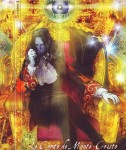 The Island of Montecristo, most famous for its role as the treasure island in Alexandre Dumas’ novel of betrayal and revenge (the best adventure story ever written, in my humble opinion), is a protected nature reserve in Arcipelago Toscano National Park, a chain of islands between the coast of Tuscany and the Island of Corsica. Giglio, the site of the ongoing Costa Concordia grounding disaster, is another island in the archipelago just east of Montecristo.
The Island of Montecristo, most famous for its role as the treasure island in Alexandre Dumas’ novel of betrayal and revenge (the best adventure story ever written, in my humble opinion), is a protected nature reserve in Arcipelago Toscano National Park, a chain of islands between the coast of Tuscany and the Island of Corsica. Giglio, the site of the ongoing Costa Concordia grounding disaster, is another island in the archipelago just east of Montecristo.
The islet is the tiny, rugged tip of an underwater volcano, and the only humans living there are one official caretaker and his family. Sights include an 18th century villa and the ruins of a 7th century A.D. monastery dedicated to Saint Mamilian of Palermo, a 5th century bishop who slew a dragon on the island and changed its name from Montegiove (“Jupiter’s Mountain”) to Montecristo (“Christ’s Mountain”). Very few tourists get to see them, however, since the island can only be reached by private yacht and only 1000 travel permits a year are issued.
Those few boats — and perhaps many others before them over the centuries — have carried an even more pernicious kind of tourist: the black rat. As they so often do, the rats have made a cozy home for themselves on Montecristo, breeding lustfully and invading every niche of the delicate islet ecosystem. There’s an estimated one rat per square meter.
Italian and European government agencies are planning to solve this problem by nuking it from orbit. It’s the only way to be sure. Okay, not exactly, but the scheme is almost as cockamamie as that. The National Park, the region of Tuscany, the Italian Ministry of Agriculture and the European Union announced that starting at the end of January, they will fly airplanes over Montecristo and drop 26 tons of pesticide pellets to kill all the black rats. They plan to use brodifacoum, an anti-coagulant poison often used as a rodenticide which is classified as “extremely toxic” for its devastating effect on mammals, birds and fish.
How do they plan to ensure none of the pellets miss the tiny tip of the volcano in the middle of an island chain national park, and having ensured this, how did they plan to ensure that only the invasive rats eat them instead of the native fauna? They have top men working on it right now. Top. Men.
Director [of the national park authority] Franca Zanichelli defends the project. “Nobody wants to poison the island,” she explains. “The project, prepared by experts, involves the use of 26 tons of food pellets, similar to that used to contain the rats everywhere, consisting of edible cereal feed which inside holds a fraction of a percent of the active poison. The baits, which can not be placed off the ground to the inaccessibility of the rugged interior, will be distributed by air with a special funnel provided by another protected area in Sardinia that has already performed a similar operation. Rat exterminations were performed with similar success in smaller Giannutri [, the southernmost islet in the Tuscan Archipelago].
Ecological groups, anti-vivisection organizations and former world champion dive fisher Carlo Gasparri (a native of Elba, home of Napoleon’s first exile and the largest island in the archipelago) vocally oppose the plan and have requested a halt to the project pending an official government investigation. Gasparri believes rats should be eradicated using a less toxic product that doesn’t persist in the environment for years, accumulating in animal tissues, tainting the food chain for God knows how long.
Fiorella Ceccacci Rubino, a representative from the ruling center-right People of Freedom party, has introduced a parliamentary inquiry on the merits of the plan, submitting that a less environmentally damaging method should be used.

P.S. – The top picture is from the phenomenal anime science fiction version of Dumas’ immortal novel, Gankutsuou: The Count of Monte Cristo. Although there are of course a number of major departures from the original, this is the only filmed version of the book I’ve ever seen that does the novel justice. If you love the book, like me, and if like me you’ve seen every live action movie version only to be disappointed, even renting the late 1990s French mini-series hoping that at least Dumas’ countrymen would respect the genius of his plot, pacing, and characterization only to stare in undisguised horror at Gerard Depardieu playing the starved and driven-to-madness Edmond Dantès in the Chateau d’If pretty much like he played Obelix, then Gankutsuou can make you whole again.